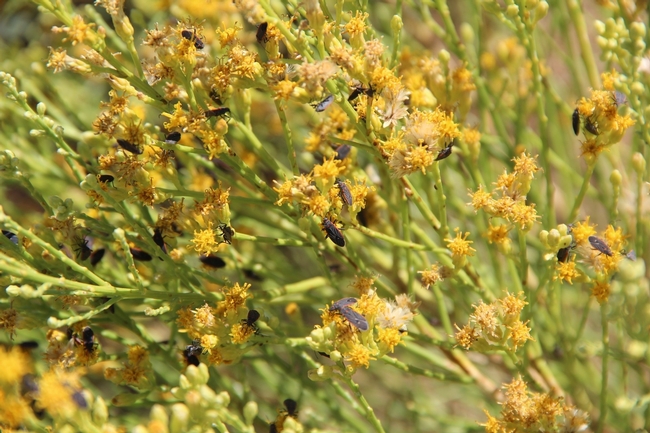
The bugs belong to a family of insects called lygaeids that are commonly referred to as seed bugs. Seed bugs use their straw-like mouthparts to extract moisture and nutrients from a wide range of plants, especially ones with seeds. The specific species of insects being found in Ridgecrest and surrounding areas is called Melacoryphus lateralis. It does not have a common name. This bug is very similar in appearance to other insects in the families Lygaeidae and Rhopalidae, such as the boxelder bug and milkweed bugs. It is not a beetle.
M. lateralis is found throughout the western United States and is most common in desert areas of Arizona, Nevada, Texas, and southern California. Immature and adult insects feed on native desert plants and then fly to find new feeding sites or mates when they are adults. Adults are highly attracted to lights and can fly long distances, especially in search of succulent plants on which to feed as desert plants become dry during mid-summer.
Populations of this insect vary from year to year with outbreaks most commonly reported in the Sonoran Desert areas of Arizona in years with elevated monsoon-like weather associated with above-average rainfall. In the areas around Ridgecrest, above-normal populations of this pest in 2015 are likely the result of a mild winter followed by above-normal rainfall in February that provided ample food for nymphs throughout the desert. Then, in July and August, the combination of drying host plants and the attractiveness of lights has caused mass migrations of the bugs to urban homes and landscapes.
Management of the bugs is difficult due to the migratory nature of adults. Pesticides that kill insects on contact, such as home perimeter treatments used by licensed pest control companies, can provide excellent control of bugs that they come in contact with, but are unlikely to have any residual effects after one or two days. Businesses and homeowners are encouraged to keep doors closed and turn off lights whenever possible after dusk to reduce the risk of attracting bugs. Once bugs get inside structures, vacuuming is the preferred method for their removal. Outdoors the bugs can be swept with a broom or blown away from business entrances, porches, or parking lots with a leafblower.
Nobody is certain how long the insects will be around. However, reports from Arizona suggest that aggregations of adults occur in July and August, which suggests that populations are likely to become reduced over the next few weeks. These reports also suggest that the outbreaks that are occurring in 2015 are likely a one-time anomaly that won't repeat itself again unless the favorable environmental conditions for the bugs are repeated. For the sake of Ridgecrest residents, let's hope that doesn't occur.